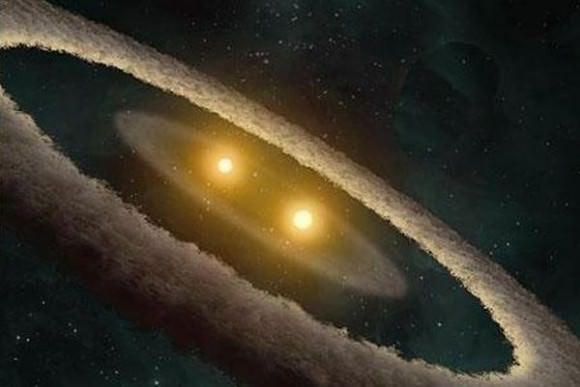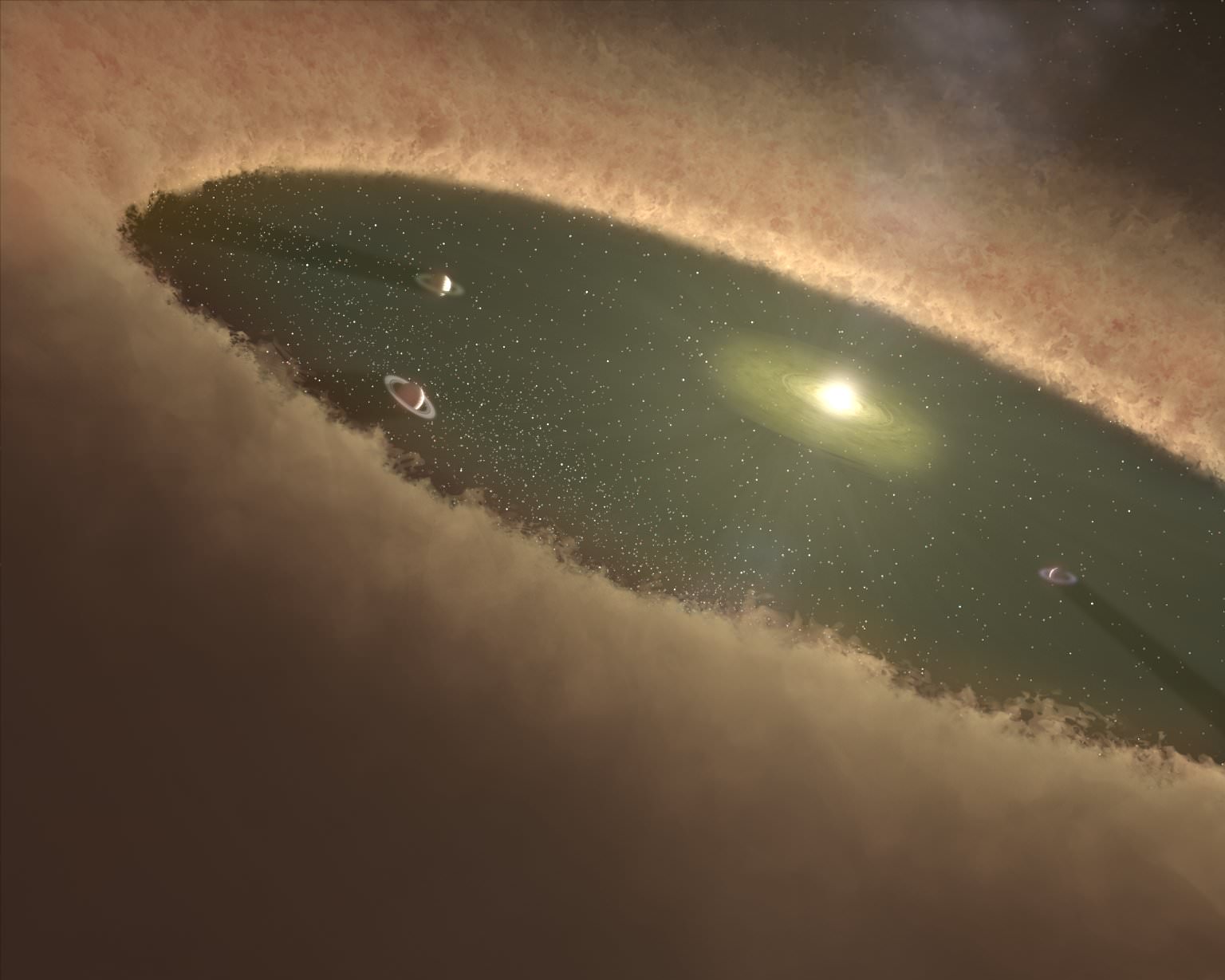[/caption]
Wanna build celestial objects? I mean it sounds easy – you just start with a big cloud of dust and give it a nudge so that it starts to spin and accrete and you end up with a star with a few wisps of dust left in orbit that continue to accrete to form planets.
Trouble is, this process doesn’t seem to be physically possible – or at least nothing like it can be replicated in standard theoretical models and laboratory simulations. There’s a problem with the initial small scale accretion steps.
Dust particles seem to stick readily together when they are very small – through van der Waals and electrostatic forces – steadily building up to form millimeter and even centimeter sized aggregates. But once they get to this size those sticky forces become less influential – and the objects are still too small to generate a meaningful amount of gravitational attraction. What interaction they do have is more in the nature of bouncing collisions – which most often result in pieces being chipped off the bouncing objects, so that they start getting smaller again.
This is an astrophysics problem known as the meter barrier.
But increasingly, theorists are coming up with ways to get around the meter barrier. Firstly, it may be a mistake to assume that you start with a uniform dust cloud, in which spontaneous accretion happens everywhere throughout the cloud.
Current thinking is that it may take a nearby supernova or a closely migrating star to trigger the evolution of a dust cloud into a stellar nursery. It’s possible that turbulence in a dust cloud creates whirlpools and eddies that favor the local aggregation of small particles into larger particles. So rather than going from a uniform dust cloud to a uniform collection of very small rocks – there is just a chance formation of accreted objects here and there.
Or we can just assume a certain stochastic inevitability about anything that has the faintest chance of happening – eventually happening. Over several million years, within a huge dust cloud that might be several hundred astronomical units in diameter, a huge variety of interactions becomes possible – and even with a 99.99% likelihood that no object can ever aggregate to a size bigger than a meter, it’s still entirely likely that this is going to happen somewhere in that vast area.
Either way, once you have a few seed objects, it’s hypothesised that the snowball process takes over. Once an aggregated object achieves a certain mass, its inertia will mean it becomes less engaged in turbulent flow. In other words, the object will begin to move through, rather than move with, the turbulent dust. Under these circumstances, it will behave like a snowball rolling down a snow covered hill, collecting a covering of dust as it plows through the dust cloud – increasing its diameter as it goes.

The time span required to build such snowballed planetesimals from a radius (Rsnow) of 100 meters up to 1000 kilometers is long. The modelling used suggests a time span (Tsnow) of between 1 and 10 million years is required.
It’s also possible to model planet formation around binary stars. Using orbital parameters equivalent to those of the binary system Alpha Centauri A and B, the snowball process is calculated to work more efficiently so that Tsnow is probably no more than 1 million years.
Once hundred kilometer-sized planetesimals have formed, they would still engage in collisions. But at this size, the objects generate substantial self-gravity and collisions are more likely to be constructive – eventually resulting in planets with their own orbiting debris, which then forms rings and moons.
There is evidence that some stars can form planets (at least gas giants) within 1 million years – such as GM Aurigae – while our solar system may have taken a more leisurely 100 million years from the Sun’s birth until the current collection of rocky, gassy and icy planets fully accreted out of the dust.
So, there’s more than a snowball’s chance in hell that that this theory may contribute to a better understanding of planet formation.
Further reading: Xie et al. From Dust To Planetesimal:The Snowball Phase?


Interesting paper. Dr. Riofrio maintains that only primordial black holes can act as suitable seeds for planet formation (see various comments in her blog “A Babe in the Universe”; possible I suppose. However, after watching the behavior of various flotsam in the eddies and vortices formed randomly in the flow of a bend in a creek or river I have been impressed by the tendency for the flotsam to aggregate in the tiny “whirlpools” evident in the turbulent flow of the water. I wonder if a similar phenomena, vastly enlarged in both space and time, occurs within a protostellar nebula and or stellar planetary disc. The resulting juxtaposition of particles within the vortex may then allow other processes, like weak gravitational forces, or other phenomena, to have the time and opportunity to become effective and permit particles to adherer to each other. Idle speculation, to be sure, but the behavior of pine needles, blossom petals, etc. is suggestive.
Watch a bit of Fluid dynamics in Zero G with Dr. Don Pettit on the ISS and it all seems quite plausible.
http://www.youtube.com/watch?v=jXYlrw2JQwo
See how Particulate matter in a fluid solution quickly coalesce into structures.
Interestingly Fluids will not rotate stably, they spin end over end. Dr, Pettit does not quite explain why, but imagine such dynamics on a water or gas planet.
These sort of dynamics could apply to Gas and Plasma as well, even solid matter over longer timescales.
We need to put a large fish tank in space pronto. 🙂
Ok, its no supercomputer simulation, but its fascinating in the context of how matter, gas and plasma can interact in Zero gravity.
Well written article, it would have been helpful to read this before sloughing through some astrobiology texts on this subject.
I was never particularly worried about the process, since protoplanetary disks are so out-of equilibrium systems that anything seems possible. In fact, the possibility of a simple statistical snowball effect is a contextually mundane pathway.
She also maintains that standard cosmology is incorrect and that the problem is GR.
Look, Louis/Louise Riofrio has a checkered history, no fault in that, but she is no doctor. What little you can hunt up from the web is that she graduated from SFSU Physics and Astronomy Department 1993 as a BS, MS or BA: “Students planning to pursue a PhD degree or to enter industry can expect an outstanding education and exposure to cutting-edge research through our B.S. and M.S. programs. The Department also offers two B.A. degrees which provide excellent preparation for prospective secondary school teachers.”
2006 this astronomer was staffed at James Cook University School of Arts and Social Sciences, Department of Anthropology, Archaeology & Sociology (while publishing in astronomy). She has exactly 0 peer-reviewed articles on cosmology or black hole physics. And now (2009-2010) she publishes on lunar regolith.
Presumably she is competent to comment on cosmology and BHs as much as I am. But I wouldn’t take her as having expertise in either area. Presumably she knows her dust though.
To put it in perspective, her 2 published papers is a start on a PhD if she wants one.
Hey, she has moved again! In the last paper she is placed at Oceaneering Space Systems in Houston, a far throw from Australia, that has diversified from an oilfield provider (the Oceaneering mother company) into space suits (Constellation/Moon contract) and space robotics, explaining her dust interest.
Also, I should have referred to her as “Louise (formerly Louis)” as per the web search. My bad!
You do not need black holes to seed planets, or at least you do not need them directly. What you do need is a measure of anisotropy an inhomogeneity in the initial or very early conditions of the universe which are “just right,” again giving us that Goldilocks condition problem. The article does point out how assumptions of an initial proto-planetary lead us to difficulties. The modelers here use this rather modest proposal to initiate the formation of planets and remove a problem due to what might be called a “force gap.” This gap refers to the strong electromagnetic interaction that saturates out due to charge balance beyond this meter scale, and the much weaker gravitational force which can only operate on scales much larger than a meter.
The inhomogeneity problem is “fixed” with inflation. The initial universe may have been enormously inhomogeneous, but the exponential expansion of the universe smoothed this out so the universe appears more or less isotropic and homogeneous. It takes about 60-folds (e^60 for e = 2.718…) to flatten things right. If one time reverses this there is an increase in clumpiness which suggests the existence of time reversed black holes. These would then be white holes, or even stranger Taub-NUT spaces bolted onto the comsic Dp-brane. Black hole physics might indirectly play a role in the establishment of initial anisotropy and inhomogeneous conditions of the universe. However, black holes are not directly present in solar system formation.
As for Riofrio’s web site, hmmm…. Interesting. This seems to be more about the culture of space and astronomy than actual science. Her idea about a variable speed of light as an explanation of dark energy (or a replacement thereof) is complete hogwash.
LC
according to scientists at LawrencevillePlasmaPhysics.com they have discovered a way to produce in 8 months, 10 times more energy then the believeable failure fusion methods, by using Hydrogen and boron to achieve giga-gauss magnetic fields with the plasma focus technique, getting gyro-radii of the order of the electron Compton wavelength. They say the size of a plasmoid (eg star) is BALANCED between COMPRESSIVE MAGNETIC FIELDS and outward expansive angular momentum spins and centrifugal forces. Too much centrifugal force, and the plasmoid doesn’t form. This fusion is clean and highly effiecient, and presents a common way that a huge dust cloud of gas can condense by charged plasma particles into stars that form a galaxy having magnetic spiral shapes.
RE: Dr. Riofrio and the alleged slowing down of the speed of light.
Until now, I had thought that only men were into such pseudoscience crap!
Hey, variable speed of light theories was last week. One difficulty with the snowball hypothesis is that plowing through dust slows them down – making their orbits decay, so most should just spiral down into the star. Solution may be 3 or n body interactions where some get flung back out into higher orbits until the dust runs out.
I don’t think they move through the dust so much as to generate a local region of dust accumulation. Clearly there is some loss of energy, for gravity is a conservative force. If these were “perfect dust” particles that did not interact the system would be “eternal” as a disk. From what I can glean from the abstract it seems the mass distribution is such that the snowball accumulates mass “gently” so these problems are lesened. The authors seem to be saying the collisions don’t become appreciable until the body is past the snowball phase at around 50km radius.
From that point I presume there must be some balance sheet where the energy lost from half the collisions is somewhat compensated for by the other half.
LC